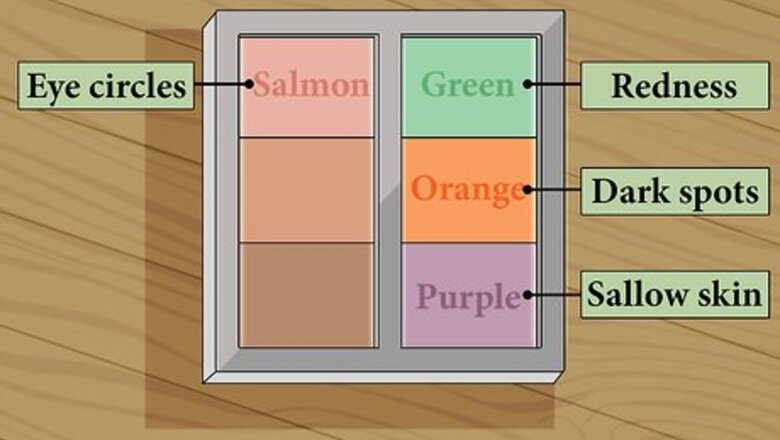
views
Finding the Right Makeup
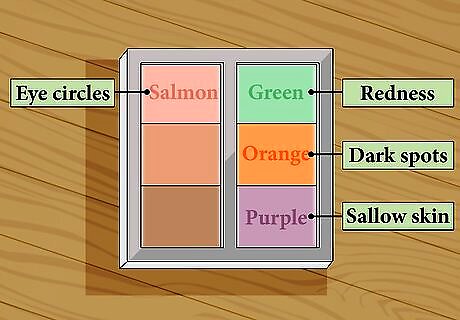
Pick the opposite color of the tone you are covering up. Whatever color you are seeking to reduce on your face, find a concealer that is the opposite tone. This is called color correction. You can find a color correcting palette that offers many different colors of concealer or you can buy them individually. In general, you should look for: Green concealer for redness Peach or orange for dark spots Purple for sallow skin Salmon for undereye circles If you are concealing dark spots, use a concealer that is one or two shades darker than your skin tone. If you are concealing undereye circles, choose a concealer that is one shade lighter. EXPERT TIP Melissa Jannes Melissa Jannes Licensed Esthetician Melissa Jannes is a Licensed Esthetician and the owner of Maebee's Beauty Studio in Philadelphia, a single practitioner space providing quality services with individualized attention. Melissa is also a National Educator for Universal Companies. She received her esthetics degree at The Beauty School of Middletown in 2008 and is licensed in both New York and Pennsylvania. Melissa won the "Best of Beauty" award from Allure magazine in 2012 for the quality of her bikini waxing. Melissa Jannes Melissa Jannes Licensed Esthetician Our Expert Agrees: Usually hyperpigmentation appears as a brownish color, so to cover it, you should use a color-correcting concealer with an orange, pink, or yellow hue. Then, use a flat brush to dab a moderate- to full-coverage foundation over the concealer. Finish by setting your makeup with powder so it will stay in place all day.
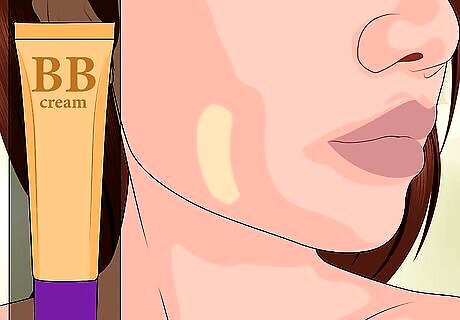
Match a foundation or BB cream to your complexion. The foundation you use will go over the concealer. You do not need a heavy foundation to cover your dark spots. Rather, find one that matches your skin tone. Alternatively, you can use a BB cream for a lighter feel on the face. BB cream offers other beneficial ingredients, such as moisturizers, salicylic acid, and SPF coverage, all of which can help reduce your hyperpigmentation as you conceal it. Test out the foundation or the BB cream on your jawline to see if it matches your face. A good foundation will blend into your skin. It should be unnoticeable to the untrained eye. The undertones of your skin can help you find the right shade. If you have yellow or green undertones, you have a warm complexion. If you have blue or red undertones, you have a cool complexion. Try to find a foundation that matches these undertones.
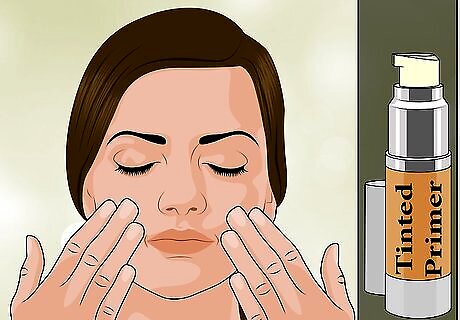
Consider tinted primers. If your hyperpigmentation takes the form of patches or rash instead of individual spots, you may want to look into getting a tinted primer as well. These primers will help makeup adhere to your face without caking or oxidizing. If tinted, they can color-correct a wide area of your face while providing a more natural look. The same color correction rules apply to primer as they do concealer. That is, use the opposite color to neutralize the hyperpigmented tone.
Evening Out Your Skin Tone
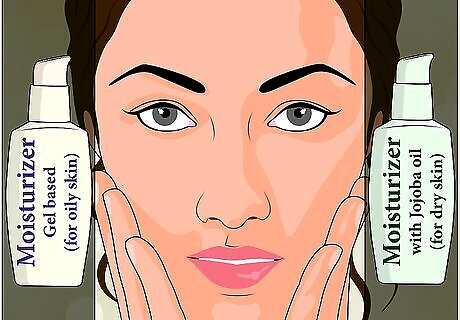
Moisturize your face. Before you apply the concealer, you want to prepare your face for makeup. Moisturizer gives your face essential hydration, and it provides a good base for your makeup. Apply to a clean face, and pat in until it is all absorbed. A good moisturizer should absorb into your skin easily without making your face feel dry or tight. If you have oily or combination skin, look for one that is water or gel-based. If you have dry skin, you may want to find one with an oil—such as mineral oil, jojoba oil, rosehip oil, or camellia oil—as one of its top ingredients. Use moisturizer even if you have oily skin. Otherwise, your skin may absorb the moisture in your makeup, causing it to have a cakey appearance. EXPERT TIP Try using a brightening serum to lighten your hyperpigmentation over time. Melissa Jannes Melissa Jannes Licensed Esthetician Melissa Jannes is a Licensed Esthetician and the owner of Maebee's Beauty Studio in Philadelphia, a single practitioner space providing quality services with individualized attention. Melissa is also a National Educator for Universal Companies. She received her esthetics degree at The Beauty School of Middletown in 2008 and is licensed in both New York and Pennsylvania. Melissa won the "Best of Beauty" award from Allure magazine in 2012 for the quality of her bikini waxing. Melissa Jannes Melissa JannesLicensed Esthetician
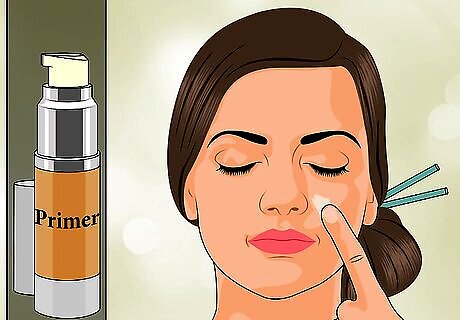
Prime your face. After the moisturizer is absorbed, squeeze out about a raisin sized amount of primer. Apply primer with your fingers or a makeup sponge. A good primer will smooth out the texture of your face without drying your face or causing it to look shiny. Primers are available in both tinted and untinted varieties. Primers are also good at smoothing out large pores, pitted acne scars, and wrinkles. If desired, look for a primer that is marketed as targeting these issues.
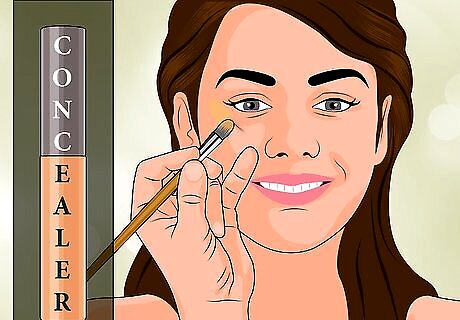
Apply concealer to troubled areas. Using clean fingers or a brush, gently put your concealer on the hyperpigmented areas. Pat it gently to spread the concealer and to blend it with your natural complexion. Be extremely gently around the eye area. The skin around your eyes is much thinner than the rest of your face. Dot the concealer under your eyes. Starting with the inner corner, pat the concealer to cover the undereye area, or make soft tapping with your fingers, as though you were playing the piano.
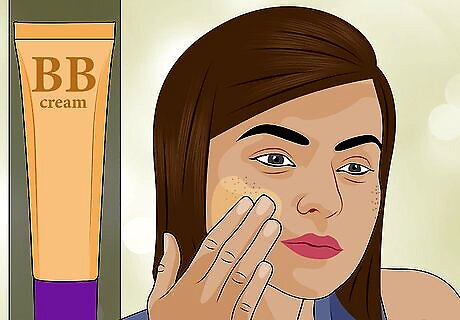
Blend with foundation. With clean fingers, a brush, or a makeup sponge, apply your foundation or BB cream in dots around your face. Blend it by patting it down and rolling your fingers or brush. Make sure your entire face is covered for an even complexion. Your concealer should not be noticeable under the foundation.

Set if desired. Setting your makeup can ensure that your makeup lasts all day. You can use a powder or a spray to set the makeup, depending on your preference and skin type. If you have oily or combo skin, a good matte powder can help your makeup remain in place all day by absorbing oil. Use a cushion or a powder brush to evenly blend it over your face. If you have dry skin, a makeup setting spray can help your complexion remain even without drying out your skin. Spray it on your skin after blending your makeup. You can reapply the spray throughout the day for a burst of hydration.
Covering Hyperpigmentation on Your Body

Wear clothing that conceals it. If your hyperpigmentation occurs on an area such as your legs, arms, neck, or back, you can wear clothing that hides it. This is especially useful if you have a rash or discoloration that is sensitive to makeup or topical treatments. Jeans, khaki trousers, leggings, stockings, and long skirts can be worn to hide hyperpigmentation on your legs. Long-sleeved shirts, jackets, kimono tops, and shawls can be worn to cover it up on your arms. If it appears on your neck, you may opt for a high collared shirt, such as a polo or oxford shirt. If it is cold outside, you can wear a scarf. Shirts will normally cover up the back or stomach. If you are wearing a bathing suit, opt for a one-piece suit (for women) or a swim shirt (for men).
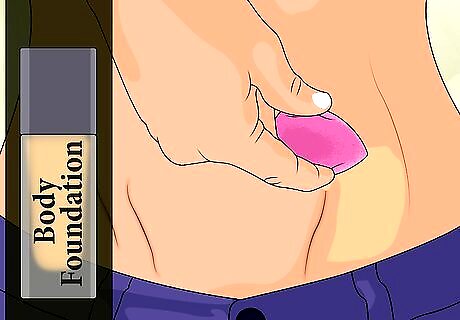
Apply body foundation. You can use foundation on your body as well as your face. Be aware that certain parts of your body--particularly those that are hidden from the sun--may be a different color than your face. You may need to find a lighter shade. Another option is to try a foundation that is specially formulated for use on your body. Pat the foundation on the affected spots with a sponge, and blend so that it looks natural. You can use concealer on these spots as you would on your face; however, it may not be as effective when applied to the rest of your body.
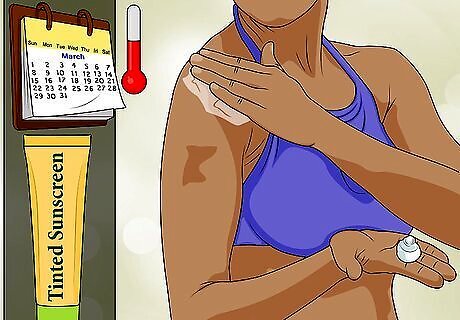
Try tinted sunscreen. Most forms of bodily hyperpigmentation are aggravated by sun exposure. In warm months, it may be difficult to wear clothing to cover these areas. Try to find a tinted sunscreen that will blend into your complexion, like a foundation, but provide essential SPF, so that the hyperpigmentation does not worsen. Ask your doctor or dermatologist for a recommendation, especially if the pigmented areas are sensitive or easily irritated.
Preventing Future Discoloration
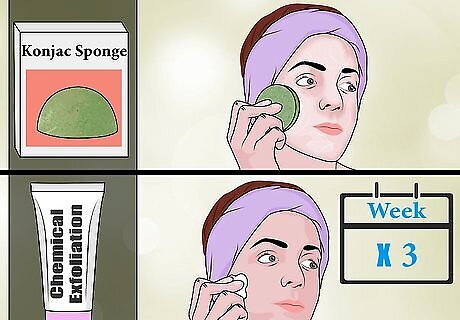
Exfoliate your skin. Exfoliation removes dead skin cells and allows your skin to regenerate. Exfoliating two or three times a week may help reduce the appearance of hyperpigmentation especially dark spots and acne scars. Do not exfoliate more than three times a week, as this can cause microtears, excessive shine, or break outs. Physical exfoliation uses a rough surface to gently roll off dead skin cells. Types of physical exfoliation include wash cloths, sugar or fruit scrubs, and konjac sponges. Wet your face, and scrub it with your chosen exfoliant before rinsing off. Be extremely gentle to prevent microtears. Chemical exfoliation uses low doses of acid to remove excess skin cells. BHA and AHA are the primary acids used. If using a chemical exfoliant, start by only using once a week to build tolerance. Before use, apply a pH-adjusting toner to your face. Use a cotton swab to apply the acid, and wait twenty minutes before applying other products. After a few weeks, you can start using it two or three times a week. Do not overuse, or you may cause a chemical burn.
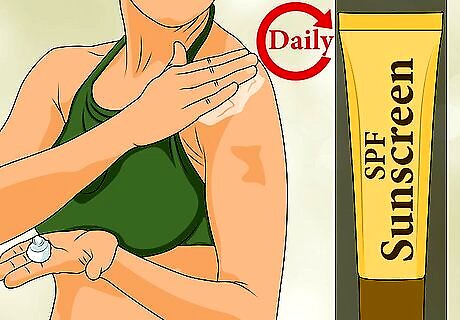
Wear sunscreen. Sunscreen is the best way to prevent future sun damage, dark spots, wrinkles, and other age-related hyperpigmentation. Use an SPF of at least 30 every day underneath your makeup. Even if you don’t plan on going outside much, daily use of sunscreen can protect your current dark spots from worsening and future ones from developing. You should use at least a nickel-sized dollop of sunscreen on your face and two tablespoons on the rest of your body.
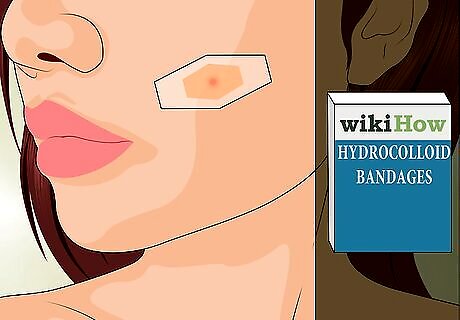
Use hydrocolloid bandages on pimples. Hydrocolloid bandages heal acne by absorbing water from the wound or pimple. They are effective at reducing acne without the subsequent hyperpigmented scarring. Apply the bandage to the pimple, and remove when it is healed. If you have lanced a pimple, the hydrocolloid dressing can prevent scarring. Sometimes you may only need to wear it overnight. Hydrocolloid bandages are widely available. They are sometimes marketed as blister bandages or pimple stickers. If the bandage is too large for the pimple, cut it to size.
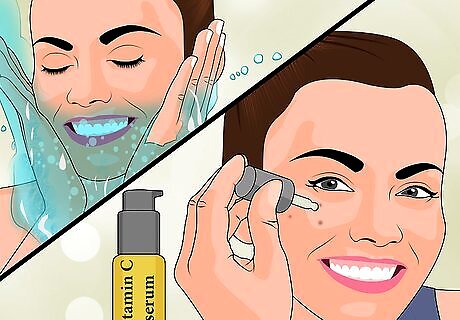
Use Vitamin C on your face. Vitamin C, also known as ascorbic acid, can lighten dark spots and reduce hyperpigmentation. It is also sometimes used to treat acne and rosacea. Vitamin C can be found in serums, moisturizers, patches, and spot treatments. If using a Vitamin C serum, apply after you wash your face and before you apply your moisturizer. If you are using a cream or serum that has niacinamide in it, it may react with the Vitamin C. This will render both ingredients useless, and it may cause your skin to flush red. Wait at least thirty minutes between applying each product.
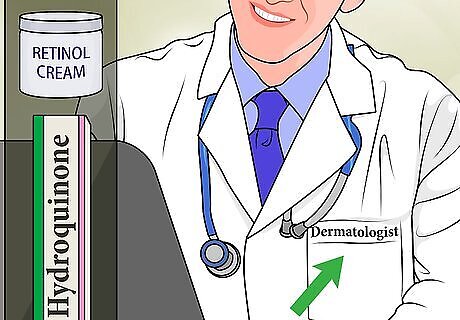
Visit the dermatologist. A dermatologist can help diagnose exactly what is causing your dark spots. They can also prescribe powerful topical remedies to reduce the dark spots on your face. Hydroquinone and retinol are common prescriptions meant to reduce hyperpigmentation. Both may dry out your skin, so make sure that you pair them with a good moisturizer. If your dark spots are severe, ask your dermatologist about laser treatments or chemical peels. These are much stronger treatments that, while expensive and harsh, can have dramatic effects.
















Comments
0 comment